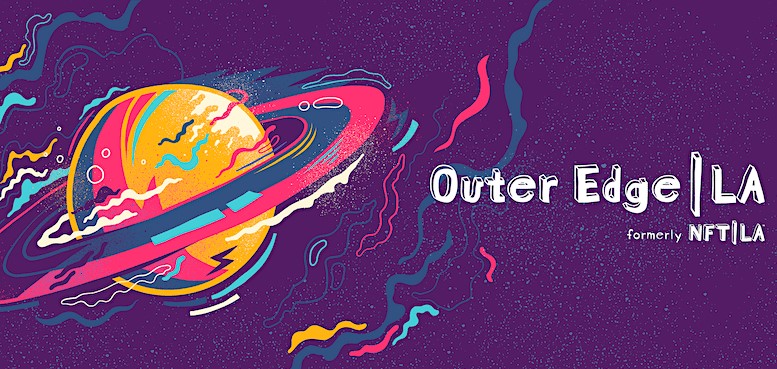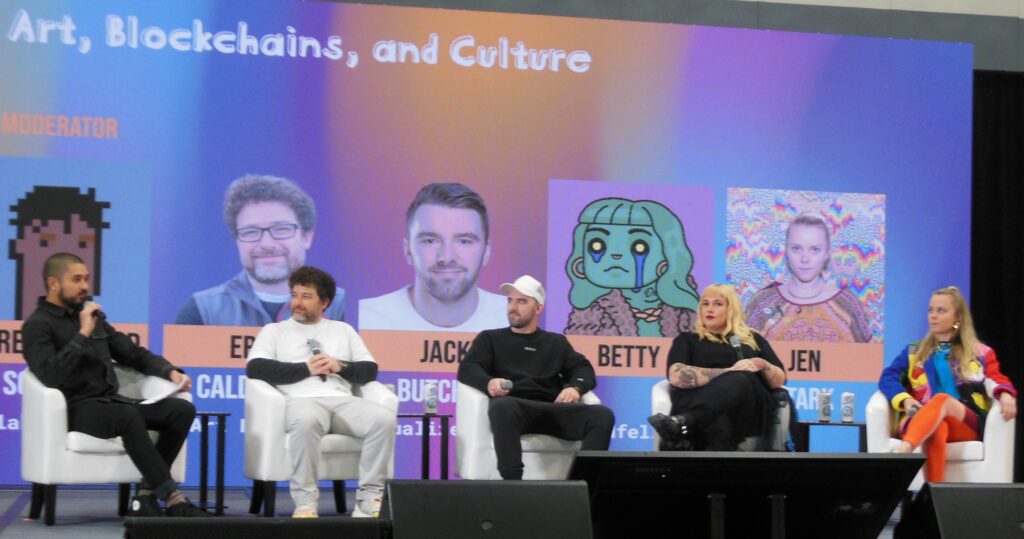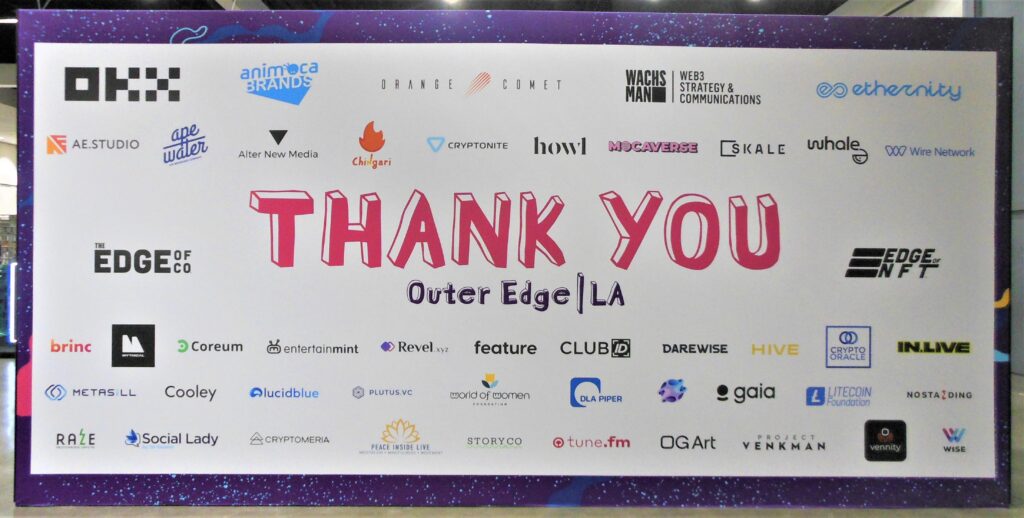Outer Edge LA 2023
Outer Edge LA 2023
Article by Angie Kibiloski
On March 21-22, I attended Outer Edge LA 2023, the NFT/web3 conference formerly known as NFT LA. The main conference sessions were held at the Los Angeles Convention Center over those 2 days, with additional community-run events throughout the week. Around 2,500 attendees wandered around a partitioned section of the West Hall, which housed a small exhibitor space of 30 or so booths, an art gallery, the main event stage, and 4 intimate breakout stages. Between them, the 5 stages hosted a variety of 70 panels comprised of 200 speakers, many of them happening concurrently all day. I was personally able to attended 20 panels, some more interesting than others, and noticed several topics that kept coming up, even if they hadn’t been the initial target of the conversation. In this article, instead of outlining every single panel I watched, with a bio and quote from every speaker, I’ve chosen 3 of those common topics that kept overlapping, and brought together thoughts from all the panelists in a cohesive way. If you’d like to see a full list of panels and speakers, head to OuterEdge.live and explore their Agenda and Speakers pages.
NFTs in Loyalty Programs with Real-World Utility
This was one of the more interesting topics of the conference for me, as it deals with some useful applications for NFTs in the wider consumer market, beyond digital art collecting and PFP flipping, into the realm of brand-driven mass adoption, through loyalty programs with real-world utility. If you’ve kept your eyes on what companies like Starbucks, GAP, and Manchester United have been doing this past year, you’ll see this already starting, and various panelists pointed out the struggles, benefits, and best practices for more companies following suit.
Any company that already has, or plans to implement a loyalty rewards program, where you earn points for your purchases or activities, could easily transition to a web3 model, and use NFTs as loyalty tokens, whether that’s a different tier of the program, or a total replacement. The struggles in doing this are 2-fold. First, there’s the issue of convincing program members that this new system is worth buying into. The second is creating a program that has enough reward benefits to retain customers while still being sustainably cost-effective for the company.
The first could be solved by reaching out to customers to educate them on the benefits of a web3 model in general, which include having more control over your own assets, the ability to transfer or sell your assets to other people, and possibly the ability to take your accrued loyalty with you to another company through partner programs. There’s also the need to make adoption of these new digital assets as seamless as possible, by making digital wallet creation quick and easy, and reducing confusion by avoiding too much emphasis on crypto and decentralization. You also need to give them something tangibly worth their effort to participate.
The second is more difficult to solve, since a company needs to continuously provide enough value for their customers to hold their loyalty tokens and stay within their community, instead of flipping them for a profit. If the company sells their digital assets, like a normal NFT project, then the customers who buy will expect the reward value they get in return to be worth at least what they paid, which could become prohibitive in the long run, especially for smaller companies. If a consumer pays $100 to be part of a loyalty program, then doesn’t feel they’re getting enough back in rewards, they could get upset and sell that asset for less, to recoup at least some of their investment. This would be counterproductive to the intent of a loyalty program, and could even hurt future NFT sales. The other option is giving tokens to customers for free, for completing activities or milestones, but this doesn’t bring in any revenue to support future rewards given out. Either way, companies have to figure out how to make it worth more to a customer to keep their loyalty assets than to sell them.
Two interesting ideas that were discussed were “soulbound tokens”, and the notion that multiple companies could partner together to offer rewards to each others’ customers, by making the tokens interoperable between their on-chain projects. First, a “soulbound token” is a digital asset that cannot be transferred, meaning once you’ve either purchased or had it dropped into your wallet, you can’t sell it or give it to someone else. I have some qualms about this type of token in general, and bad actors taking advantage of that tech, but that’s a topic for another time. For good-intentioned rewards programs, this assures the customer that they’ll never lose their accrued loyalty history, and even act as immutable proof of their reputation as a quality consumer outside of that original program. Now to the next point about brand partners. Companies already do this in a fashion, like getting discounts at the gas station with points earned at the grocery store, but by taking this idea into web3, you could expand this without having so much backend tech development needed between companies. It could be as easy as adding a token-gated login to the partner company’s app or online store, and there are platforms that provide an easy bridge for this service already.
Creators and Community-Building
The numerous panels about creators in the space also spoke about real-world utility, and how artists and musicians can incorporate that into their projects to attract and retain more fans, and turn them into community members instead of just buyers. They also spoke about managing ROI expectations of collectors, and trying to guide the general mindset away from using a piece of art or music as a quick flip for profit, and more towards collecting something to support an artist and become part of their inner circle. Finally, they stressed the importance of retaining royalties for NFT creators across all marketplaces, which has been a pillar of the web3 ethos, or risk driving creators away from the space altogether.
Regarding real-world utility from creators, this can come in a variety of forms depending on the project. Artists might sell token-gated merchandise featuring art from their NFT collection, available only to token holders, or maybe send holders free prints of their piece. Musicians might have holder-only access to live concerts or backstage experiences, or perhaps free signed copies of their CD if you’ve bought their full NFT album. Whatever the utility, the point is to provide collectors with more than just your digital work, and make them feel more personally invested in you and your product. This builds trust in you as a creator, and forms a tight community of your collectors. Sometimes NFTs gets associated with financial scandals and sensationalism, but it’s the community element that’s at the heart of why so many creators continue to be passionate about web3.
Thinking about managing a collector’s expectations, artists can make it crystal clear if their project should be collected for the sake of the art and community, or if they have an actionable roadmap to create real financial returns for their collectors. This space gets so caught up in the money-making aspect, fueled by the handful of famous projects that have made their collectors fortunes, that some people think every NFT should make them rich. Those projects are the exceptions, not the norm, yet collectors still expect to buy a $100 NFT and turn around and sell it for $1,000, then get angry at the creator when this doesn’t happen. Not every NFT project is a financial commodity, some are just art. Ideally, this space needs to put more emphasis on the primary sales of a project, and the benefits of collecting a piece to hold it, and shift away from the flipper mindset of the secondary market. If we can do that, more collectors will be happier with their purchases, and fewer creators will get death threats.
Royalties are important, in the NFT space and the traditional market alike, and without them creators can’t survive off of their work. Consumers have grown accustomed to not paying for content, starting with the piracy download sites decades ago, and leading to streaming services taking advantage of that formed habit. One reason why NFTs have been so important to creators is that royalties could be coded into their work, so that every time a collector sold a piece on the secondary market, the creator would get a percentage as well. This allowed some artists to make a living on their work for the first time. Several months ago, some marketplaces began to build workarounds into their platforms, so collectors could avoid paying royalties to the creator of the work they were selling. Of course, they did still enforce the site fees to get their own cut, it was just the creators that the collectors could choose not to pay. Creators and smart contract developers are fighting back with better-coded contracts, and even blocking certain marketplaces from indexing their work, but there needs to be a shift back away from the mentality that creators don’t deserve to be paid when someone else profits from their IP. Aside from once again trying to build community, and change the way collectors view the value of not just the art or music, but the worth of the creator behind it, it’s unclear how we make people understand the need for non-optional royalties.
The Multiverse of Metaverses
The final topic I want to touch on will be brief, as any useful implementation of a metaverse seems still in its infancy, but several panels spoke about its potential future, in a way that might be disappointing for some. Aside from one speaker who actually did think we were headed for a totally immersive, interconnected, VR metaverse in the vein of Ready Player One, the rest took a more compartmentalized, practical view. The tech just isn’t there yet, nor the desire from companies from every industry to house all their virtual presences under the same roof.
A more likely scenario is that companies will spin up their own little pocket metaverses, walled ecosystems accessible through their own portals. These could be virtual storefronts, museum collections, garden environments, or live event venues. The point is, they’ll be singular purpose-driven spaces. They also probably won’t all be in VR. A metaverse can simply be an immersive, interactive, digital space, where you can walk around as an avatar and socialize with other visitors, browse and purchase goods, attend events, etc. The key thing will be to make all of these individual spaces interoperable, so that you can come and go from all of them with your same, personalize avatar. Your digital identity in the metaverse should function just like yourself in real life, the same person when you walk into the grocery store as when you walk into the movie theater. As long as we can retain our “selves” as we cross between metaverses, we can wait on the tech to catch up for the mega-metaverse that some people hope for.
Some Final Thoughts
Outer Edge LA 2023 was packed from start to finish with back-to-back panels. With so many hours of info to pick apart and collate, I hope I’ve made these 3 topics interesting and understandable. I’ll end with some final thoughts that didn’t quite fit with the rest, but are worth mentioning. NFTs will play a part in the future of our transactional lives, though with the stigma attached to that acronym, we’ll likely be calling them something different. With the recent traditional bank crashes, more people will be realizing the benefits of Defi and financial self-custody, and onboarding them smoothly and safely will be key. That’s where “shared custody” platforms like Coinbase come in handy. They aren’t full web3, because they aren’t totally decentralized, but they have the benefit of providing the (near) self-custody and transparency of blockchain technology, while also providing security, ease-of-use, and a bit of hand-holding for the protection of new users. Of course, with increased adoption of web3 tech, regulations are on the horizon. It’s very important, however, that regulators educate themselves about all the use cases of the technology before setting the policies, so they aren’t stifling the success of multiple industries in the process. Regulate the potential bad actions, not the tech itself, or risk falling behind the rest of the world where utilization of web3 has been made a priority. There’s a big shift coming, where NFTs won’t primarily be seen as collectibles, but also as access tokens for real-world goods, services, and experiences. Personally, I look forward to participating in all of it. For more in-depth info, check out OuterEdge.live as a good starting point.







